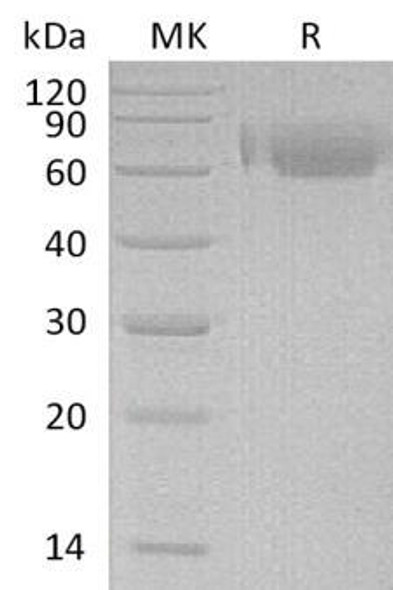Anti-Human ILT1, Isotype Control, Fc Muted (Clone 135.5 (LALAPG) (IVMB0554)
- SKU:
- IVMB0554
- Product Type:
- Monoclonal Antibody
- Clone:
- DC101
- Host Species:
- Rat
- Reactivity:
- Mouse
Description
| Product Name: | Anti-Mouse CD309 (VEGFR2) |
| SKU: | IVMB0554 |
| Size: | 1 mg, 5 mg, 25 mg, 50 mg, 100 mg |
| Antibody Type: | Hybridoma Monoclonal Antibody |
| Clone: | DC101 |
| Target: | VEGFR2 |
| Isotype: | Rat IgG1κ |
| Host Species: | Rat |
| Reactivity: | Mouse |
| Applications: | FA WB |
| Synonyms: | CD309, KDR, FLK-1, vascular endothelial growth factor receptor 2 |
| Product Concentration: | ≥ 5.0 mg/ml |
| Purity: | ≥95% monomer by analytical SEC >95% by SDS Page |
| Recommended Isotype Controls: | Rat IgG1 GOLD |
| Recommended Dilution Buffer: | In vivo Antibody Diluent pH 7.2 |
| Immunogen: | Recombinant full-length Mouse VEGFR2 protein |
| Endotoxin Level: | < 1.0 EU/mg as determined by the LAL method |
| Antigen Distribution: | VEGFR-2 is widely expressed by vascular endothelial cells, some vascular tumors, carcinomas, malignant melanomas, and lymphomas. Certain leukemia cells express functional VEGFR on the cell surface. |
| Formulation: | This monoclonal antibody is aseptically packaged and formulated in 0.01 M phosphate buffered saline (150 mM NaCl) PBS pH 7.2 - 7.4 with no carrier protein, potassium, calcium or preservatives added. Due to inherent biochemical properties of antibodies, certain products may be prone to precipitation over time. Precipitation may be removed by aseptic centrifugation and/or filtration. |
| Specificity: | DC101 activity is directed against VEGFR-2. |
| Additional Applications Reported In Literature: | FA WB |
Vascular endothelial growth factors (VEGF) and VEGF receptors (VEGFR) play an essential role in angiogenesis1. There are three VEGFRs: VEGFR-1, VEGFR-2, and VEGFR-3. VEGFR-1 and VEGFR-2 are responsible for angiogenesis, and VEGFR-3 affects lymphogenesis. In the pathogenesis of diseases including diabetes mellitus, rheumatoid arthritis, and cancer, new blood vessel formation is highjacked. Changes at the VEGF/VEGFR-2 axis are particularly potent at allowing VEGF-induced proliferation, migration, and vascular endothelial cell differentiation during tumor angiogenesis. Additionally, VEGFR-2 is upregulated in tumor vascular endothelial cells, and VEGF levels are associated with poor prognosis and resistance to chemotherapy. Consequently, the VEGF/VEGFR axis is a prime anti-cancer target.
DC101 greatly reduces melanoma tumor growth and cell proliferation in murine mouse models without adverse effects as well as promotes tumor vessel normalization2. Additionally, DC101 therapy enhances immune cell penetration of melanoma cells by increasing the proportion of CD19+ B cells, CD11c+ dendritic cells, and CD3+ and CD8+ T cells. DC101 treatment also increases expression of PD-1 and PD-L1 in CD45+ immune cells and tumors. Additionally, DC101 directly inhibits angiogenesis in vivo, and, in tumors, reduces xenograft tumor growth, decreases endothelial cells and microvessel density, and increases tumor cell apoptosis3.
DC101 binds to an extracellular, ligand-binding domain on the amino-terminal of VEGFR-2, thereby blocking ligand binding and preventing VEGF165-induced receptor phosphorylation4. DC101 has been used in Cy5.5-, FITC, and HYNIC-labeled chitosan conjugates to study VEGFR-2 expression in ischemia5.
| Ligand/Receptor: | VEGF-A, VEGF-C, and VEGF-D splice isoforms |
| State of Matter: | Liquid |
| Regulatory Status: | Research Use Only |
| Product Preparation: | Functional grade preclinical antibodies are manufactured in an animal free facility using in vitro cell culture techniques and are purified by a multi-step process including the use of protein A or G to assure extremely low levels of endotoxins, leachable protein A or aggregates. |
| Storage and Handling: | Functional grade preclinical antibodies may be stored sterile as received at 2-8°C for up to one month. For longer term storage, aseptically aliquot in working volumes without diluting and store at -80°C. Avoid Repeated Freeze Thaw Cycles. |
| UniProt: | P35918 |
| Research Area: | Cell Biology, mmunology |







